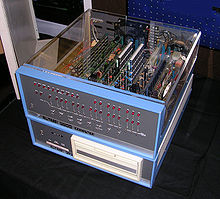 A few days ago one of the pioneers of the home computer revolution of the 1970s died. Ed Roberts, an MD in Georgia, died after a long battle with Pneumonia. Back in the 1970s his company, MITS, moved from model rocket telemetry, to calculators, then to building the first ‘computer kit’ – the Altair 8800 – for which Bill Gates and Paul Allen provided a BASIC interpreter. The Linux and Apple Fanbois amongst you may now know who to blame for Microsoft… 🙂
A few days ago one of the pioneers of the home computer revolution of the 1970s died. Ed Roberts, an MD in Georgia, died after a long battle with Pneumonia. Back in the 1970s his company, MITS, moved from model rocket telemetry, to calculators, then to building the first ‘computer kit’ – the Altair 8800 – for which Bill Gates and Paul Allen provided a BASIC interpreter. The Linux and Apple Fanbois amongst you may now know who to blame for Microsoft… 🙂
It’s debatable that without the Altair 8800 another home computer – in kit or ready built form – would have come along. The Apple 2 followed behind theAltair, as did many other similar machines, but the Altair was first.
The Altair 8800 was basically a microprocessor chip with enough associated ‘gubbins’ to make it work – it could be chipped up to have 8k of memory – my laptop here has 4,000,000 k of memory – and could even handle a keyboard and eventually a video display – although when you got it out of the box (and after you’d soldered the thing together) it'[s user interface was a bank of toggle switches and some LEDs.
Yup – you programmed it, entered data and read the output in binary. It was safe to say that in the mid 1970s, as far as computers were concerned, men were real men, women were real women, and real programmers did it in binary with a soldering iron tucked behind their ear. The fact that within 10 years of the Altair being launched teenagers were typing their own programs in to Spectrums, ZX-81s, BBC Micros, Apples and the rest is a monument to the excitement and speed of those early days of computing.
And, by golly, it was FUN! Even the act of getting your computer working in the first place was part of the game – you learnt to code in machine code from day one because either nothing else was available or you realised that in order to make anything useful happen with only a few HUNDRED bytes of memory you needed to right VERY ‘tight’ code.
I built my first computer in the mid-1970s – well, not so much a computer as a programmable calculator. I took an electronic calcul;ator and wired up the keyboard to some circuitry of my own invention that mimicked keypresses. Programming this beast involved changing the wiring in my circuit – running teh program involved pressing a button and after a few seconds the answer would appear. I then got even smarter, and managed to work out how to introduce some decision making in to my gadget. Fortunately, I blew the output of the calculator up soon afterwards – I say fortunately because I then found out about microprocessors and ended up building some simple computer circuits around 6800 and Z80 microprocessors, rather than carrying on with my rather ‘steampunk’ programmable calculator!
Ed Roberts’s machine wasn’t an option for me; my pocket money wouldn’t cover the postage from the US. But the fact that people were doing this sort of thing was very exciting, and by the time I left university in 1982 I’d already spent time with ZX81s and Apple 2s, and had written my first article for the home computer press – a machine code monitor and loader program for the ZX81 in ‘Electronics and Computing Monthly’. I was reading in the magazines about the developments of software from up and coming companies like Microsoft – even in those pre-PC days – and for a few years in the early 1980s the computing field in the UK was a mish-mash of different machines, kits, ready made stuff – and most people buying these machines bought them to program them. How different to today.
I have to say that I’ve always thought that the fun went out of home computing when the PC came along, and when Microsoft and Apple stopped being ‘blokes in garages’ and started being real companies.
Ed Roberts – thank you for those fun packed years!
